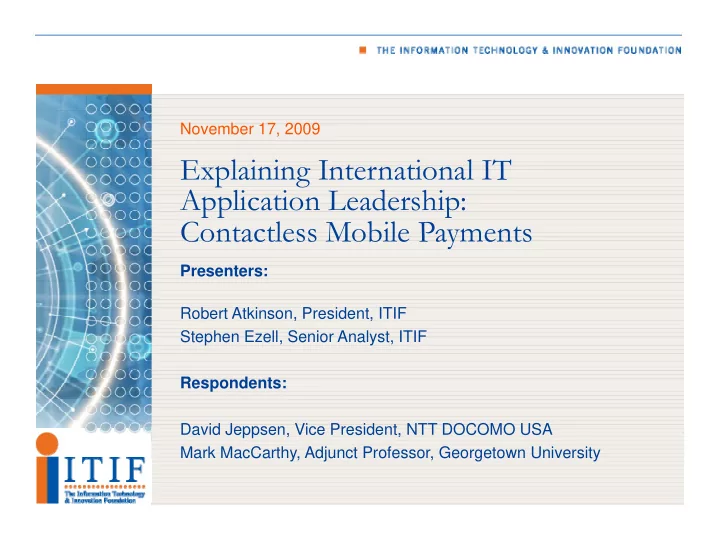

November 17, 2009 Explaining International IT Application Leadership: Contactless Mobile Payments Presenters: Robert Atkinson, President, ITIF Stephen Ezell, Senior Analyst, ITIF Respondents: David Jeppsen, Vice President, NTT DOCOMO USA Mark MacCarthy, Adjunct Professor, Georgetown University
Today’s Presentation 1 Which countries are leading in mobile payments? 2 What factors have led to their success? 3 What can the U.S. learn from the global leaders? 4 Policy recommendations for the United States. 2
Which Counties Lead in Contactless Mobile Payments? Metric/Statistic Japan South Korea United States Mobile phone 87% 93% 88% penetration Number mobile wallet 78 million 12 million Only in trials capable phones Number citizens using 17 million phones; 3.6 million phones; Only in trials mobile wallets 68 million smart cards 18 million T-money smart cards Number merchants 608,000 merchants/ 500,000 POS 140,000 merchants deploying POS readers/ total number POS readers deployed deploying/500,000 Total number deployed readers greater POS readers 3
Contactless Mobile Payments in Japan DOCOMO’s Vertically Integrated Approach: � Forged 2004 relationship with Sony to develop osaifu-keitai � Exerted leverage on device manufacturers to produce FeliCa-enabled phones � Subsidized the deployment of reader terminals with merchants � Took equity position in Sumitomo Mitsui Card � Put marketing muscle behind promoting contactless mobile payments � Did not seek exclusive rights to Mobile Felica But why did DOCOMO do all this? 4
Contactless Mobile Payments in South Korea T-money � Launched in 2004 by Korea Smart Card Company JV � A transportation card and electronic money platform � Designed from the beginning to be extensible and interoperable � 30M contactless transactions/day in mass transit; 3M as electronic money Mobile T-Money SK Telecom’s Moneta � Mobile wallet application launched 2002 � Met with middling success � Fears of technology lock-in � Distrust from bank partners 5
Non-Policy Factors Policy Factors Long time horizon; Competition receptive to PPPs Vertically Ecosystem integrated facilitation ecosystem Mobile Spur demand; culture/lifestyle Early adopter What factors contribute to success with High density urban Set conditions contactless population mobile payments? 6
How Governments Drove Mobile Payments Japan � Government strategy based on conscious decision to furnish overall direction and motivate activity of private sector. � Subtle, behind-the-scenes role to ensure collaborative alignment of actors. � Openly worked to promote FeliCa as a global standard for mobile wallets. South Korea � Spearheaded creation of Korea Smart Card Company. � Organized and hosted formal meetings with carriers and banks to support standards setting. � Developed mobile payment systems for taxis and other public services. 7
Examples of Government Engagement Singapore � Formed a roundtable group of banks, mobile network operators, and transit companies, with intent of developing national NFC strategy. � Created a national trusted third party to ensure interoperability between NFC services of mobile operators and service providers. United Kingdom � Smart and Integrated Ticketing Study assessed deploying universal smart ticketing coverage in UK public transport. � Found benefit of deploying NFC for contactless payments could save £2B/yr. 8
What Can the United States Learn from Global Leaders? � Transit operators, card issuers, and mobile operators should work out upfront electronic wallet capabilities/standards for smart cards and mobile phones. � Need for a fully-open, interoperable mobile payments system. � Opportunity is missed if electronic wallet is not a multifunctional device with cash, information storage and transaction, ID, and communication features. � Participation of mass transit systems is critical. � Government engagement is crucial to catalyze demand, set conditions, and facilitate ecosystem development. 9
Policy Recommendations for Contactless Mobile Payments � Create an inter-government mobile payments working group and private sector advisory council to develop a U.S. mobile wallet strategy � Government at all levels should assume a leadership role 1) Require mass transit agencies to deploy interoperable contactless systems 2) Deploy NFC-enabled POS terminals in all government facilities 3) Require gov ID programs to house electronic wallets on the card � Harmonize and extend consumer protections � Recognize enhanced security of contactless payments � Encourage competition and do not favor entrenched interests 10
Thank you! sezell@itif.org 202.465.2984 www.itif.org 11
Recommend
More recommend